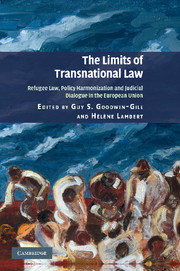 The Limits of Transnational Law
The Limits of Transnational Law Book contents
- Frontmatter
- Contents
- Notes on contributors and editors
- Acknowledgements
- Abbreviations
- 1 Transnational law, judges and refugees in the European Union
- 2 Where is the reference? On the limited role of transnational dialogue in Belgian refugee law
- 3 Transnational refugee law in the French courts: deliberate or compelled change in judicial attitudes?
- 4 The use of foreign asylum jurisprudence in the German administrative courts
- 5 The solipsistic legal monologue of Italian authorities
- 6 ‘Thou shalt not judge’ … Spanish judicial decision-making in asylum and the role of judges in interpreting the law
- 7 The British judiciary and the search for reciprocal relations with its continental partners
- 8 Speaking across borders: the limits and potential transnational dialogue on refugee law in Ireland
- 9 The absence of foreign law in Danish asylum decisions – quasi-judicial monologue with domestic policy focus?
- 10 Foreign law in Swedish judicial decision-making: playing a limited role in refugee law cases
- 11 The search for the one, true meaning …
- Bibliography
- Index
8 - Speaking across borders: the limits and potential transnational dialogue on refugee law in Ireland
Published online by Cambridge University Press: 06 July 2010
- Frontmatter
- Contents
- Notes on contributors and editors
- Acknowledgements
- Abbreviations
- 1 Transnational law, judges and refugees in the European Union
- 2 Where is the reference? On the limited role of transnational dialogue in Belgian refugee law
- 3 Transnational refugee law in the French courts: deliberate or compelled change in judicial attitudes?
- 4 The use of foreign asylum jurisprudence in the German administrative courts
- 5 The solipsistic legal monologue of Italian authorities
- 6 ‘Thou shalt not judge’ … Spanish judicial decision-making in asylum and the role of judges in interpreting the law
- 7 The British judiciary and the search for reciprocal relations with its continental partners
- 8 Speaking across borders: the limits and potential transnational dialogue on refugee law in Ireland
- 9 The absence of foreign law in Danish asylum decisions – quasi-judicial monologue with domestic policy focus?
- 10 Foreign law in Swedish judicial decision-making: playing a limited role in refugee law cases
- 11 The search for the one, true meaning …
- Bibliography
- Index
Summary
Introduction
Refugee law and policy have expanded rapidly in Ireland over the last decade. Historically a land of emigration, it is only in recent years that questions relating to asylum law have been at the centre of legal and political debate. Refugee law and policy have developed in Ireland against a background of significant transnational legal activity. As in most other areas of Irish law, judges, lawyers and policymakers, frequently engage with and draw upon the decisions of other national courts in deciding upon refugee matters. Transnational legal activity, and judicial dialogue in particular, has had a significant impact on the evolution of refugee law in Ireland. The more recent development of refugee law in Ireland is particularly relevant in examining the scope of transnational judicial dialogue in this field. The ready availability of foreign law in recent years has ensured that a diverse range of legal sources can be cited and drawn upon with relative ease by Irish courts. As refugee law in Ireland has developed largely in the last ten to fifteen years, this easy availability of foreign law sources has contributed to an emerging consensus on the meaning of key legal concepts in refugee law. Another notable feature of the development of refugee law in Ireland is the frequent reference to leading academic authorities in the field, in particular Guy S. Goodwin-Gill and James Hathaway.
- Type
- Chapter
- Information
- The Limits of Transnational LawRefugee Law, Policy Harmonization and Judicial Dialogue in the European Union, pp. 150 - 169Publisher: Cambridge University PressPrint publication year: 2010


